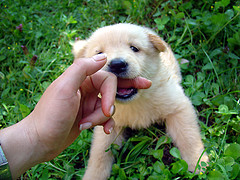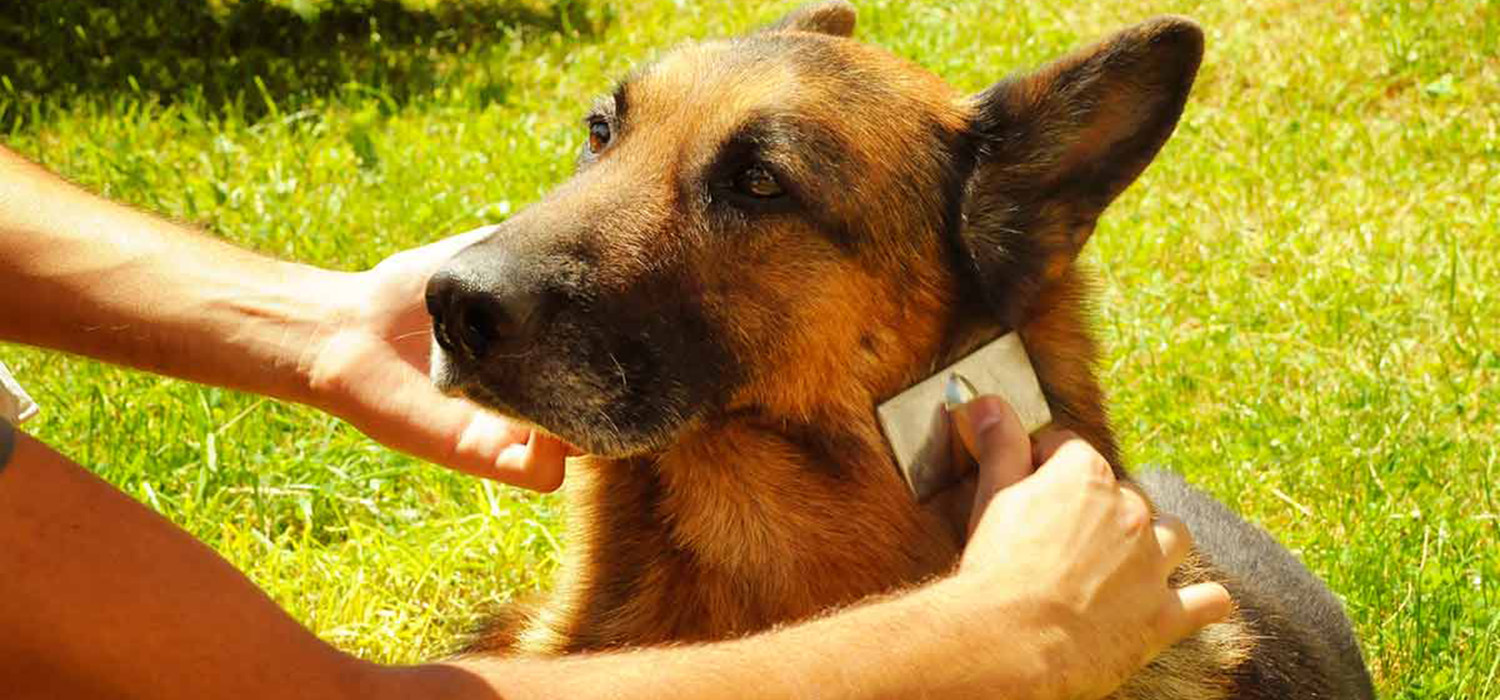 Biting Behavior
Biting Behavior
Without a doubt, teaching your puppy to ‘be gentle’ when it comes to mouthing humans and other animals is the single most important item on the educational agenda of any dog owner. Bite inhibition training, or inhibiting the pressure of your puppy’s biting behavior, should be one of the critical lessons of any kindergarten or comprehensive puppy training program. If you are looking for a top quality puppy training class run by qualified dog trainers, look no further than Karen Pryor’s Clickertraining.com for a list of her recommended dog trainers! Every puppy must be taught to inhibit the force of its biting behavior so that it develops a soft mouth, particularly when it comes to humans and other animals. Your puppy must subsequently be taught to inhibit the frequency of its ‘now gentler mouthing’, so that the adolescent dog learns to keep its jaws to itself and never mouth any person or their clothing.
 Dog Going Through Chew Toys In A Day? Buy Antler Chews! Antlers and Horns
Dog Going Through Chew Toys In A Day? Buy Antler Chews! Antlers and Horns
are a great, healthy, long-lasting chew for your pooch!
It is as unrealistic to expect dogs never to be frightened or annoyed by people, as it is to expect people never to frighten or annoy each other. However, just as it is reasonable to expect people to resolve their disagreements without physical violence, it is both realistic and perfectly feasible to teach dogs never to physically harm a person when scared or provoked.
Dogs suffer incessant provocation from people, especially from children and men, and a large proportion of dogs are involved in some kind of aggressive altercation with humans at some time in their lives. But in such instances, both the prognosis for rehabilitation and the fate of the dog are almost always dependent on how much damage the dog inflicted–that is, the dog’s level of bite inhibition.
Before and After Getting Your Puppy: The Positive Approach to Raising a
Happy, Healthy, and Well-Behaved Dog
Dr Ian Dunbar dedicates a whole chapter in his above book to helping dog owners to understand the importance of ‘good bite inhibition’. He explains that it is a normal and natural puppy behavior and when puppies receive feedback by yelping or squealing they learn what is appropriate and to soften the pressure. This is a very worthwhile resource book and a MUST READ, particularly if you are new to raising a puppy. The purpose of this book is to emphasize and reiterate the importance of teaching your puppy the necessary behaviors whilst during the developmental stage, which makes training urgent and critical.
Levels of Aggression
Ideally, all dogs should be taught never to respond aggressively to any kind of provocation, but this is impossible in practice, especially in instances of extreme and unexpected provocation. Let’s look at the following case histories. In the first four, a dog was provoked and responded in an understandable way.
Case 1: An 8-year-old struck out during a baseball game and hit the dog’s muzzle with a baseball bat. The dog yelped and ran.
Case 2: A woman tripped, dropped a cup of hot chocolate over the dog and fell headlong into the dog’s face while it was gnawing on a bone. The dog nipped the woman on the cheek but did not puncture the skin.
Case 3: A woman hurrying to answer the phone pierced the dog’s thigh with her high-heel. The dog bit her on the ankle, causing three punctures basely 1/4 inch deep.
Case 4: A man grabbed the dog’s cheeks with both hands, shook the dog vigorously, flipped it on its back and screamed obscenities in the dog’s face. The dog sliced the man’s ear with two punctures–little damage but a lot of blood.
Case 5: A 3-year-old toddled up to the dog and reached out to pat it on the head. The dog bit the child in the face five times.
In each case, whether the scared and/or provoked dog ran, hid, growled, snarled, snapped, nipped, bit or savaged depended primarily on the degree of learned bit inhibition established in puppyhood.
Because the dogs exercised remarkable restraint and demonstrated fairly solid bite inhibition in the first four cases, these were resolved easily with basic, commonsense people education and dog training. However, in the fifth case, the dog was euthanized and the child was physically and mentally scarred for life. The dog had obviously not been socialized with children, but more damning, the dog had very little bite inhibition at all. When bite inhibition is poor or nonexistent, if and when the dog bites, in addition to the serious injury caused to the victim, invariably the dog loses its life and the owner loses a companion, peace of mind and often a lawsuit.
Save an Extra 5% – 10% on Every Autoship order with Chewy!
Inhibit Force Before Frequency
A puppy’s needle-sharp teeth and its often rapacious penchant for biting are essential for the establishment of bite inhibition and the development of a soft mouth. Puppy biting hurts but seldom causes any appreciable harm. In fact, puppy biting behavior is the way a young pup learns that its jaws can hurt. It is important puppies learn to inhibit the force of their biting before they acquire the blunt yet formidable teeth and strong jaws of an adolescent dog.
Although the abrupt and total curtailment of puppy biting (if possible) offers immediate relief to most owners, it often reflects only a short-term gain and does not always augur well for the future. If the puppy is forbidden to bite, it will not have sufficient opportunity to learn that its jaws may inflict pain. Thus, if it is ever provoked to bite as an adult, the resultant bite is likely to be a hard one, causing severe damage. Certainly puppy biting must be controlled, but only in a progressive, systematic manner, whereby the pup is taught to inhibit the force of its bites.

To inform the puppy that biting hurts, it is not necessary to hurt, frighten, punish or even reprimand the pup; a simple “Ouch!” is sufficient, in a higher pitched tone of voice, as if mimicking another puppy. If the pup acknowledges the “ouch” and desists, praise and resume playing but in a calmer manner. If the puppy ignores the reprimand, emphasize “OOOUUCHH!” and then walk away immediately, leaving the puppy alone to settle down.
Learning Good Biting Behavior Through Play
As when playing with their litter mates or mom’s teats and tail, puppies quickly learn that hard bites lose playmates. By setting up specific play sessions to continue the puppy’s learning about good biting behavior, you will be cementing in the puppy’s brain what is and is not appropriate. As you play with your puppy and you feel harsher biting because the puppy is getting more excited, do the squeal or “OUCH”, remove yourself from your puppy and then return one or two minutes later and make up by having the puppy come, sit and calm down before resuming play. By separating yourself from the puppy, it reinforces the same responses as what the puppy had started learning in the litter pack.
 You should notice after some practice that the puppy’s mouthing and biting becomes softer. Once the pup’s mouthing no longer hurts, still keep pretending it does. Greet harder munches with a yelp of pseudo-pain. The puppy will begin to get the idea, thinking, “Whooahh! These humans are super-sensitive. I’ll have to be much more gentle.” The force of the puppy’s biting will progressively decrease until biting becomes mouthing and eventually, mouthing succumbs to gumming or slobbering.
You should notice after some practice that the puppy’s mouthing and biting becomes softer. Once the pup’s mouthing no longer hurts, still keep pretending it does. Greet harder munches with a yelp of pseudo-pain. The puppy will begin to get the idea, thinking, “Whooahh! These humans are super-sensitive. I’ll have to be much more gentle.” The force of the puppy’s biting will progressively decrease until biting becomes mouthing and eventually, mouthing succumbs to gumming or slobbering.
Never allow the puppy to mouth human hair or clothing, simply because you cannot feel any pain and therefore you don’t know the pressure of the bite. If your puppy does bite clothing and hair, then treat it has a very hard bite with the squeal “OUCH” and remove yourself from the puppy. Allowing a pup to mouth hair, scarves, shoelaces or gloved hands inadvertently trains it to bite harder, extremely close to human flesh!
Once the puppy’s mouthing no longer exerts any palpable pressure whatsoever, then and only then can you teach the pup to reduce the frequency of its oral proclivities. Teach the meaning of “Off!” by hand-feeding kibble, so the pup may learn very gentle mouthing is okay, but it must stop the instant you say, “Off!”
And of course, allowing mouthing to resume is the best reward for a puppy that stops mouthing on request. At this stage the puppy, or young adolescent dog, should never be allowed to initiate mouthing (unless requested to do so).
Nip It In the Bud
Some dogs learn to inhibit the force and frequency of biting quickly and naturally, whereas for other dogs bite inhibition must be actively taught as a specific exercise. After just a few weeks of instruction, the “mouthy” breeds and their puppies from hell characteristically curtail hard biting fairly quickly, since the owner is immediately aware of the problem and takes appropriate action and the puppy has more than ample opportunity to learn its biting hurts.
It may seem paradoxical, but puppies that are mouthing maniacs and/or puppies that grow up with children are much more likely to develop gentle jaws and a soft mouth as an adult. On the other hand, shy, reserved and /or fearful dogs, which often do not play as much and therefore seldom roughhouse or bite their owners, and breeds that have been bred to have soft mouths, seldom present much of a puppy problem to their owners and therefore do not receive sufficient feedback concerning the power of their jaws.
All too often, when a dog has bitten severely the case history reveals the dog was “fine” as a puppy. This is the major reason we go to great pains to encourage shy and standoffish dogs to play in puppy class. The most important survival lesson for a puppy to learn is that when it bites, it causes pain. Of course, the pup can only learn this lessen if it bites and if the bitee gives appropriate feedback.





